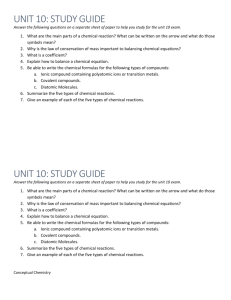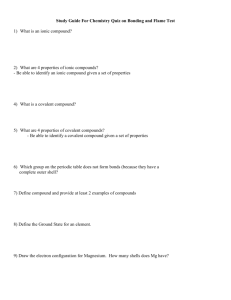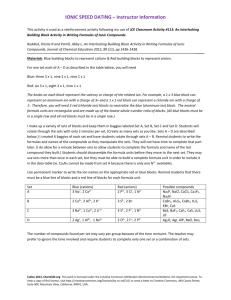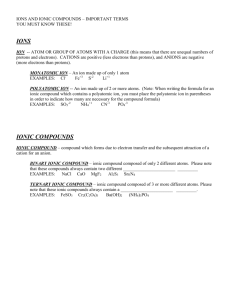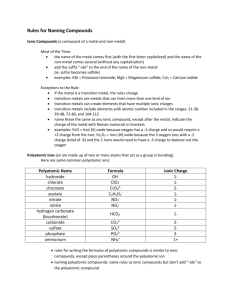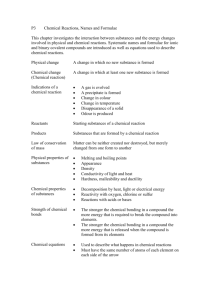Names and Formulas of Compounds
advertisement
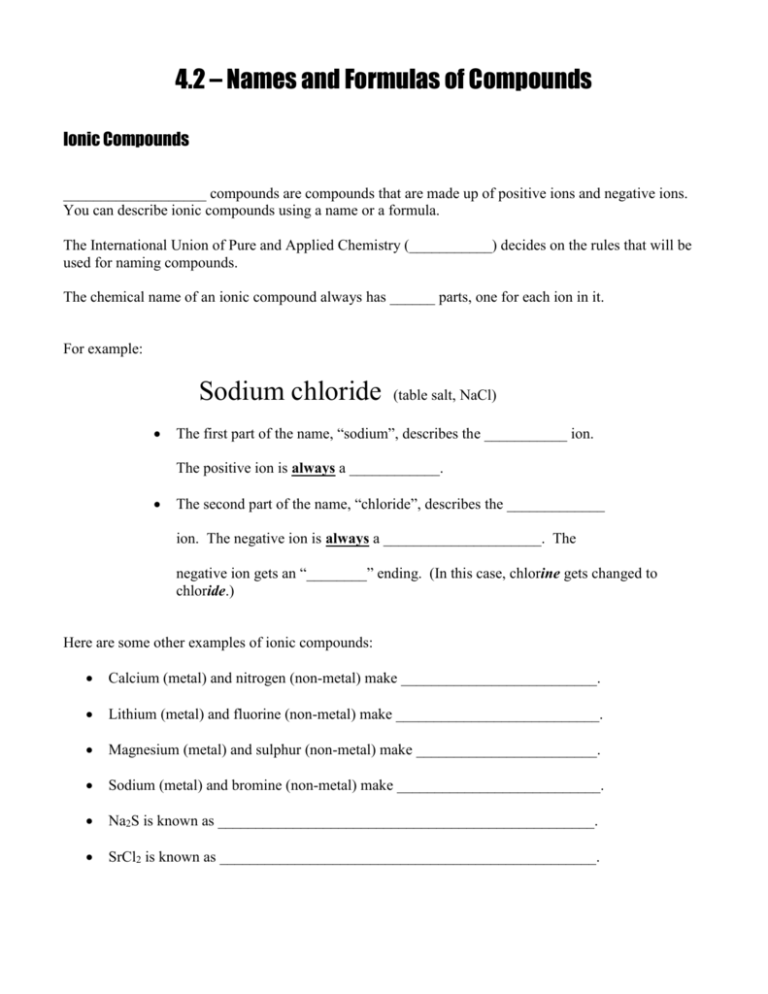
4.2 – Names and Formulas of Compounds Ionic Compounds ___________________ compounds are compounds that are made up of positive ions and negative ions. You can describe ionic compounds using a name or a formula. The International Union of Pure and Applied Chemistry (___________) decides on the rules that will be used for naming compounds. The chemical name of an ionic compound always has ______ parts, one for each ion in it. For example: Sodium chloride (table salt, NaCl) The first part of the name, “sodium”, describes the ___________ ion. The positive ion is always a ____________. The second part of the name, “chloride”, describes the _____________ ion. The negative ion is always a _____________________. The negative ion gets an “________” ending. (In this case, chlorine gets changed to chloride.) Here are some other examples of ionic compounds: Calcium (metal) and nitrogen (non-metal) make __________________________. Lithium (metal) and fluorine (non-metal) make ___________________________. Magnesium (metal) and sulphur (non-metal) make ________________________. Sodium (metal) and bromine (non-metal) make ___________________________. Na2S is known as __________________________________________________. SrCl2 is known as __________________________________________________. Here are some examples of ionic compounds: In an ionic compound, the number of positive charges must equal the number of negative charges so that the overall compound is electrically ________________. Potassium bromide has one + charge and one – charge. Magnesium chloride has two + charges and two – charges. Aluminum sulphide has six + charges and six – charges. How to Write Formulas for Ionic Compounds 1. Figure out which ions are in the compound and what their charges are. 2. “Swap and drop” the charges on the ions. (There should be exactly the same number of positive and negative charges in the ion so that they cancel out and the entire molecule is neutral.) 3. Write the formula, using subscripts to show how many of each element there is. (The + and – signs from the charges disappear as soon as the numbers drop down.) 4. If the subscripts are multiples of each other, reduce the formula like you would reduce a fraction. For example: Write formulas for the following ionic compounds: Zn+2 with I- _____________________ Al+3 with P3- _____________________ Ca+2 with O-2 _____________________ Barium phosphide Lithium fluoride Aluminum nitride _____________________ ____________________ _____________________ Multivalent Metals Some metals are ____________________________, which means they can form ______ in more than one way, depending on the situation. The periodic table always lists the more common ion above the less common ion(s) for each metal. When naming a compound that contains a multivalent metal, we must use Roman numerals to show which charge the metal ion has. For example: Ni+2 is referred to as nickel (II), or “nickel two” to show that it has a charge of +2. V+4 is referred to as vanadium (IV) or “vanadium four”. If you have a multivalent metal, naming or writing a formula for an ionic compound follows exactly the same rules as before, only you have to include a roman numeral in the name to show the charge on the metal. Metal Ion Charge +1 +2 +3 +4 +5 +6 +7 Roman Numeral I II III IV V VI VII For example: Write names for the following compounds: SnBr2 _________________________________ VCl5 __________________________________ Ni2S3 __________________________________ FeCl3 __________________________________ NbF5 __________________________________ Write formulas for the following compounds: Copper (I) nitride ____________________ Manganese (IV) oxide Chromium (III) bromide Cobalt (II) oxide ____________________ _____________________ ___________________ Palladium (IV) iodide ____________________ Polyatomic Ions A _____________________ ion is made up of more than one type of atom joined by covalent bonds. Some examples of polyatomic ions are: CO32-, OH-, and NH4+. Polyatomic ions are always paired up with ions that have an ________________ charge. So, for example, hydroxide, OH-, would pair up with a positively-charged ion, and ammonium, NH4+, would pair up with a negatively-charged ion. When writing formulas for compounds that contain polyatomic ions: 1. Figure out which ions are present and what their charges are. 2. “Swap and drop” the charges. 3. If you have more than one of a particular polyatomic ion, you must use brackets and write the subscript outside the brackets to show that the subscript applies to all of the atoms in the ion. When writing names for compounds that contain polyatomic ions: 1. If the first ion is a metal, it keeps its name. If the first ion is a polyatomic ion, it keeps its name. If the metal is multivalent, it needs roman numerals to show its charge. 2. If the second ion is a non-metal, it gets an “ide” ending. If the second ion is a polyatomic ion, it keeps its name. For example: Mg+2 and CO3-2 ____________________________________ K2Cr2O7 ______________________________________ Fe(OH)3 ______________________________________ Ammonium chloride _________________________________ Manganese (III) chlorate __________________________________ Vanadium (V) phosphate __________________________________ Covalent Compounds ___________________________________ compounds are made up of two non-metallic elements. Atoms in covalent compounds do not join by forming ions. Instead, they connect chemically by ________________ their electrons. We use a different system of naming for covalent compounds than the one we used for ionic compounds. The subscripts in a covalent compound always show the exact number of atoms in a molecule. We do not reduce the numbers like we do in ionic compounds. For example: Hydrogen peroxide, H2O2 (Liquid you put on cuts that goes, “bubble, bubble”!) ***Notice that the chemical formula for H2O2 does NOT get reduced to HO. We use prefixes to indicate how many of each type of atom exists in a binary covalent compound. Prefix Number Prefix Number monoditritetrapenta- 1 2 3 4 5 hexaheptaoctanonadeca- 6 7 8 9 10 To write the name of a binary covalent compound: 1. The first element gets its own name. Only use a prefix if there is more than one of the first element. 2. The second element always gets a prefix, and an “ide” ending. For example: CO _____________________________________ N2O3 ______________________________________ PCl5 ______________________________________ Si2O3 _____________________________________ To write the formula of a binary covalent compound: 1. Use the prefixes to tell you how many of each type of atom there is. (Remember that if there is no prefix in front of the first element, there is only one atom of that type.) 2. Do NOT reduce the formula the way you do with an ionic compound. For example: Nitrogen tribromide ____________________ Disulfur decafluoride Diphosphorus pentoxide ____________________ ____________________ Carbon tetrafluoride _____________________ Phosphorus disulphide _____________________ REMEMBER: You must check to see whether a compound is ionic or covalent so that you know which of the two naming systems you should use! HOW TO TELL IF A COMPOUND IS IONIC OR COVALENT: IONIC Contains a metal and a non-metal. Contains a polyatomic ion. You can tell if there’s a polyatomic ion present because the compound will contain more than two types of elements. Might have a Roman numeral in the name. COVALENT Contains only non-metals. Does not contain polyatomic ions. Never has a Roman numeral in the name.
